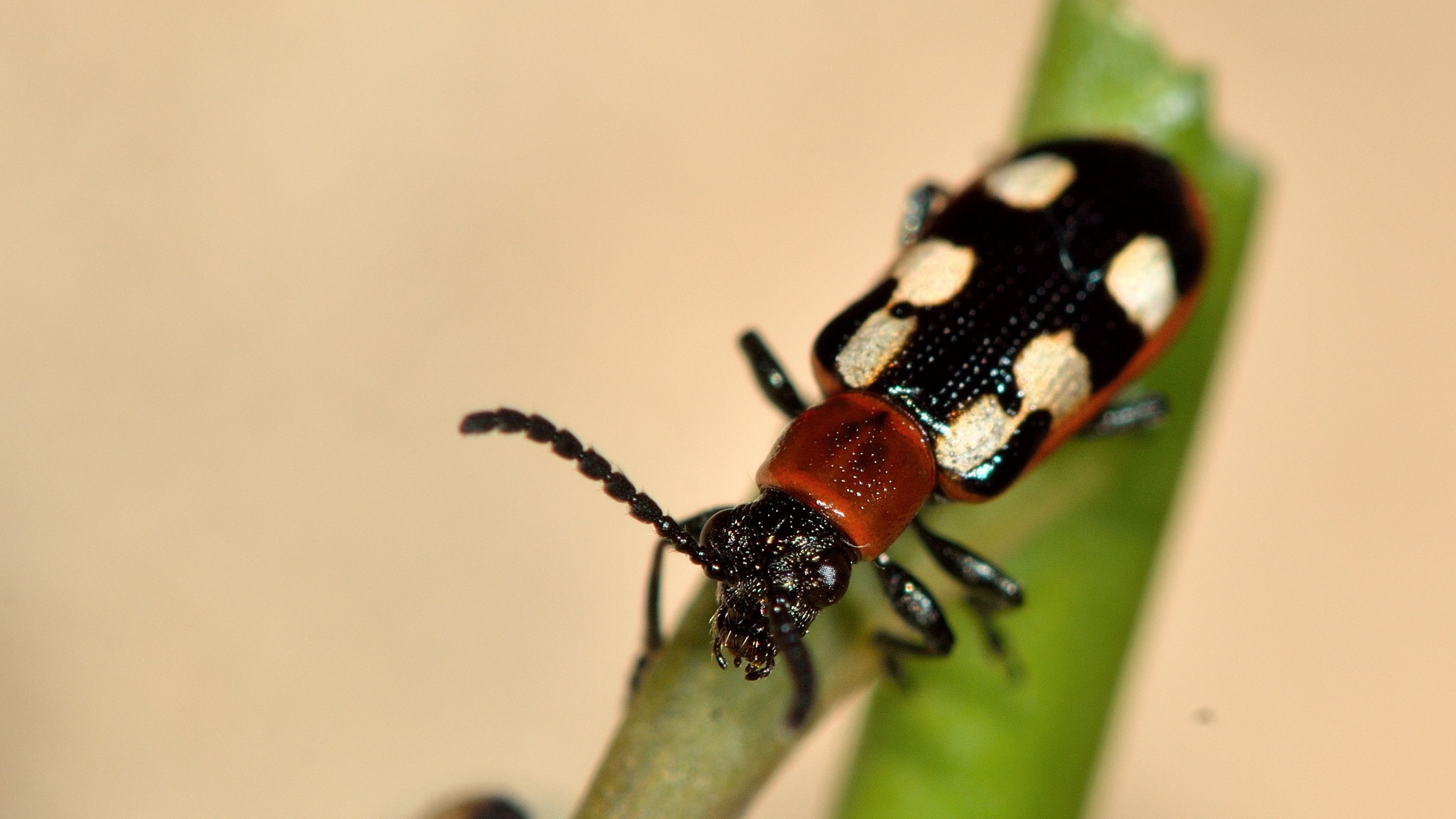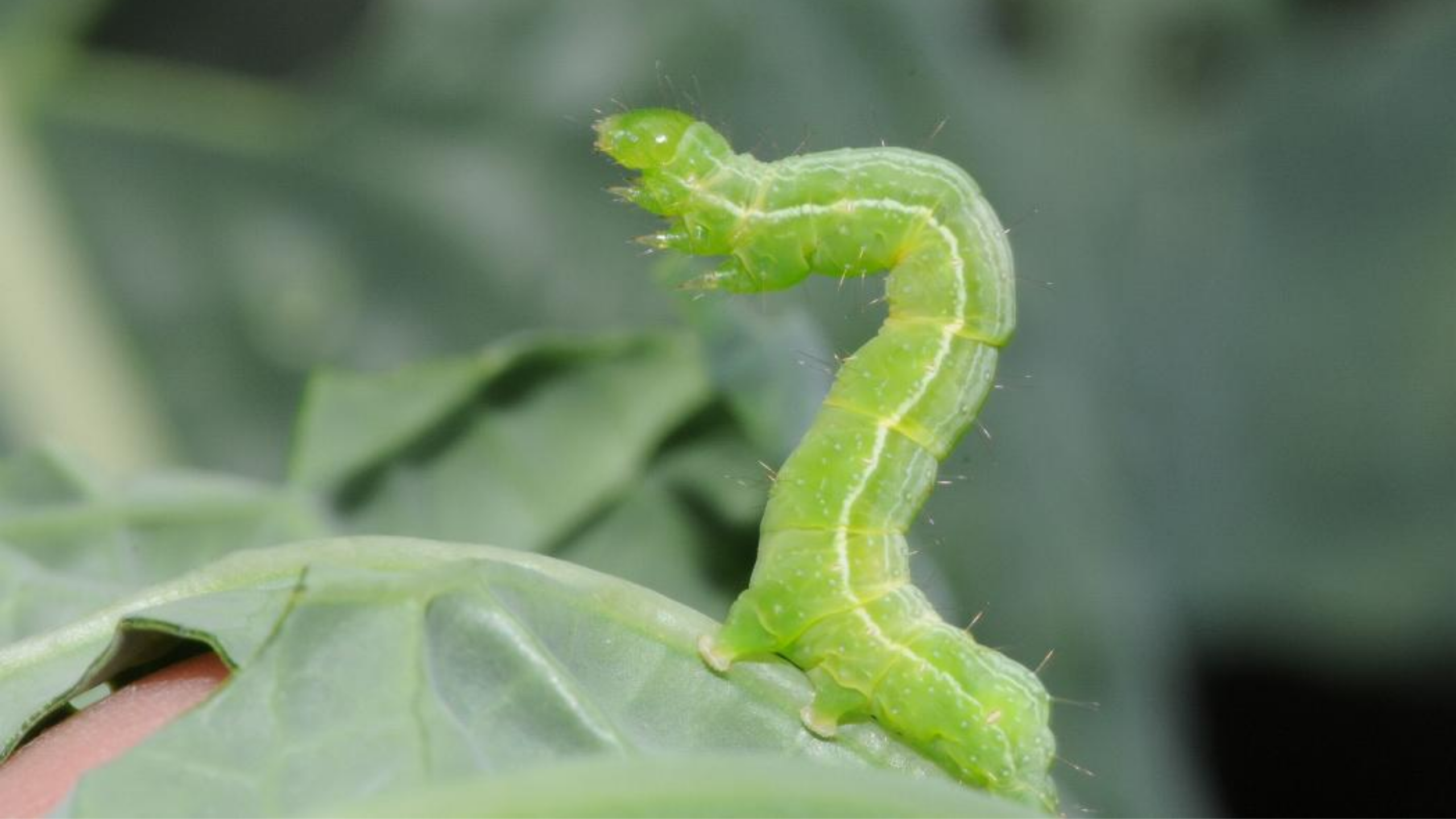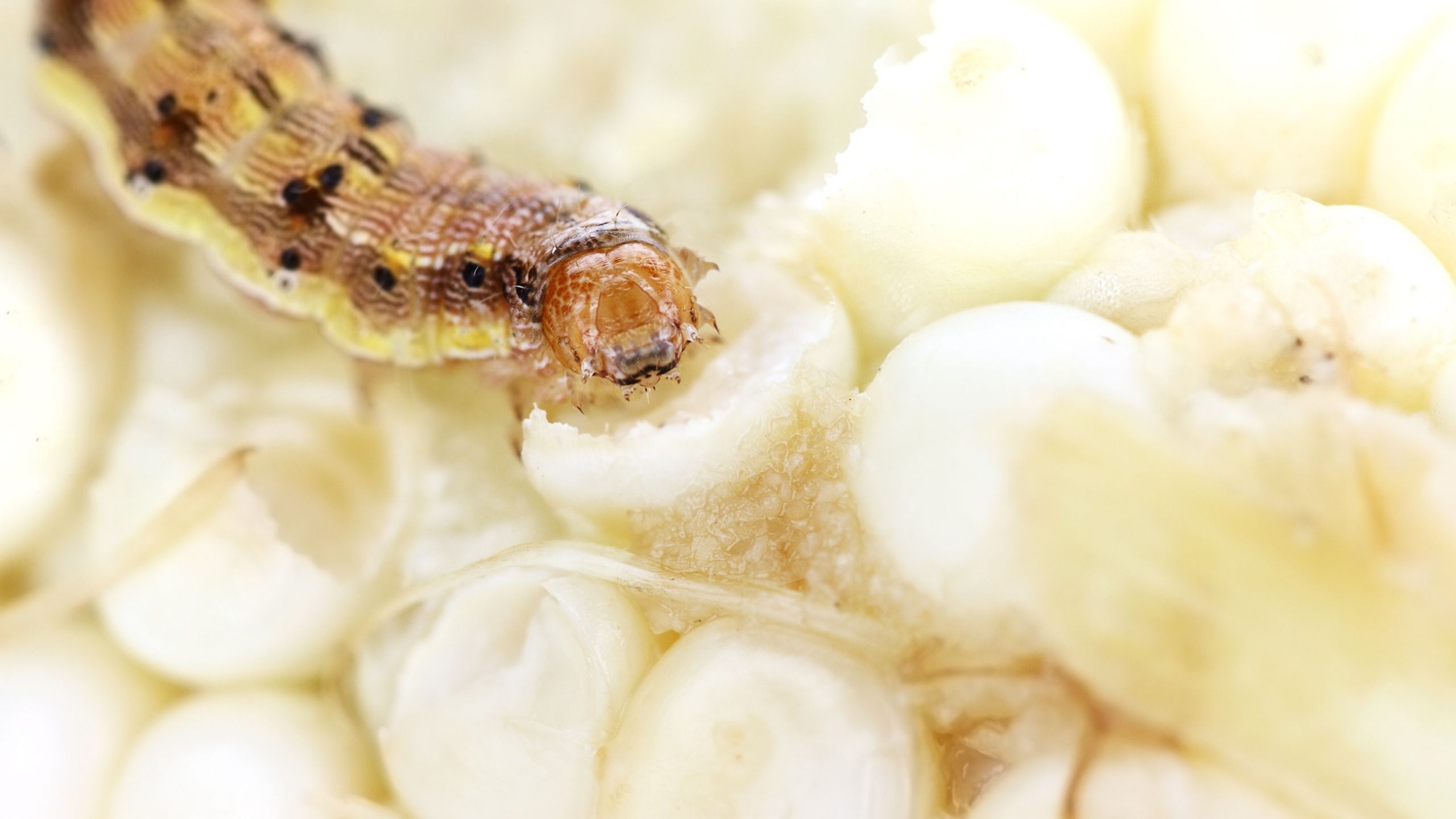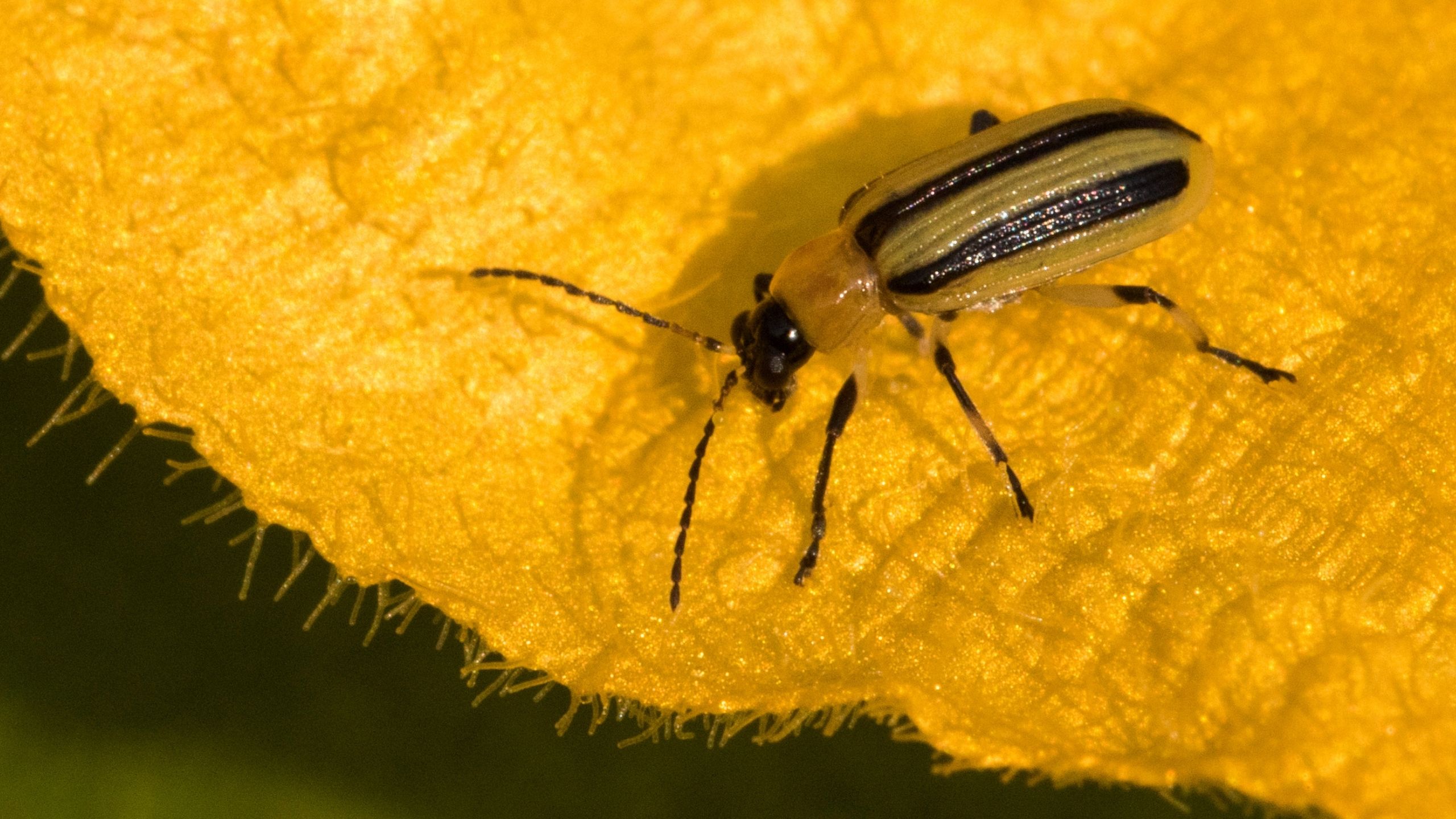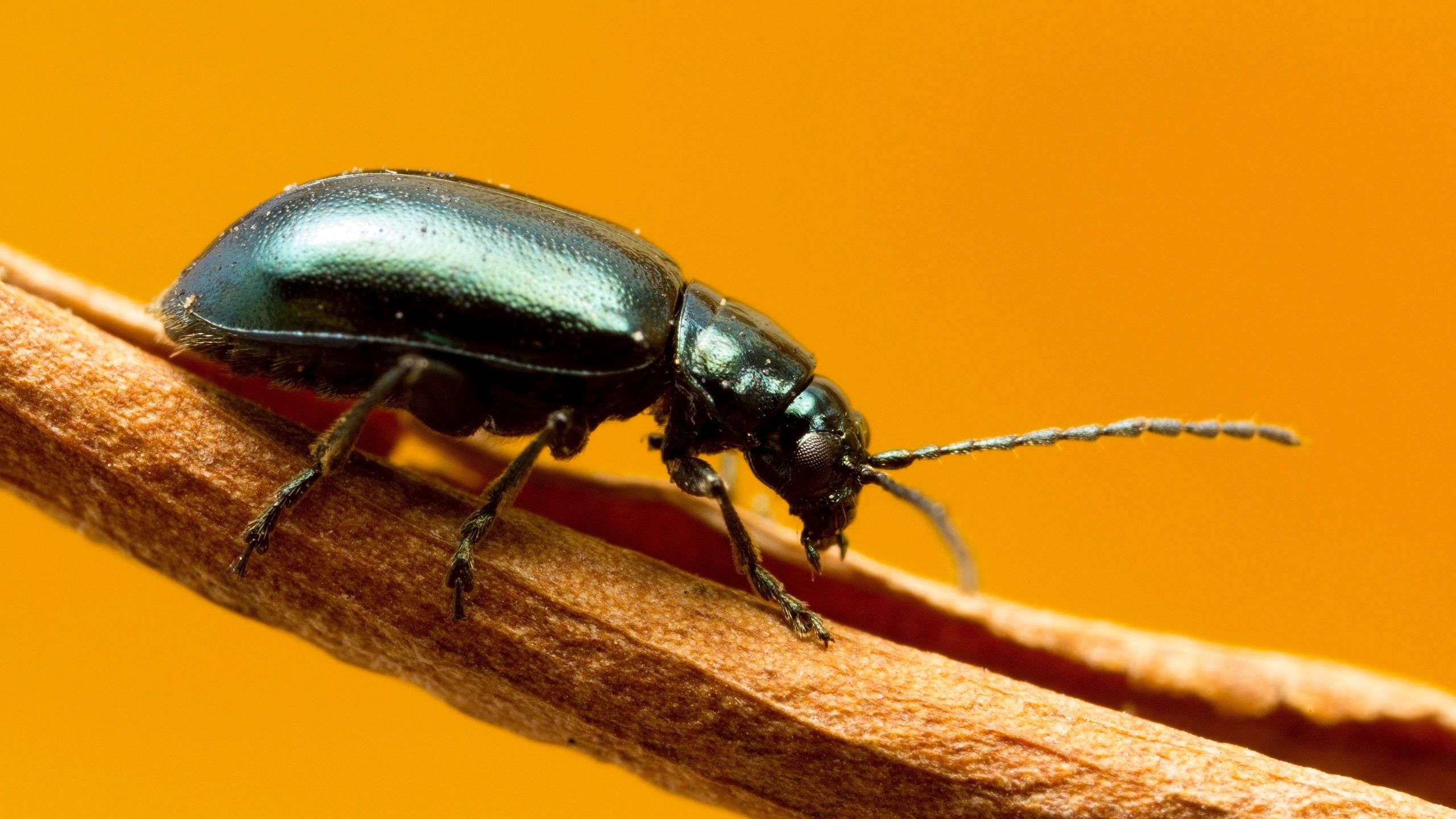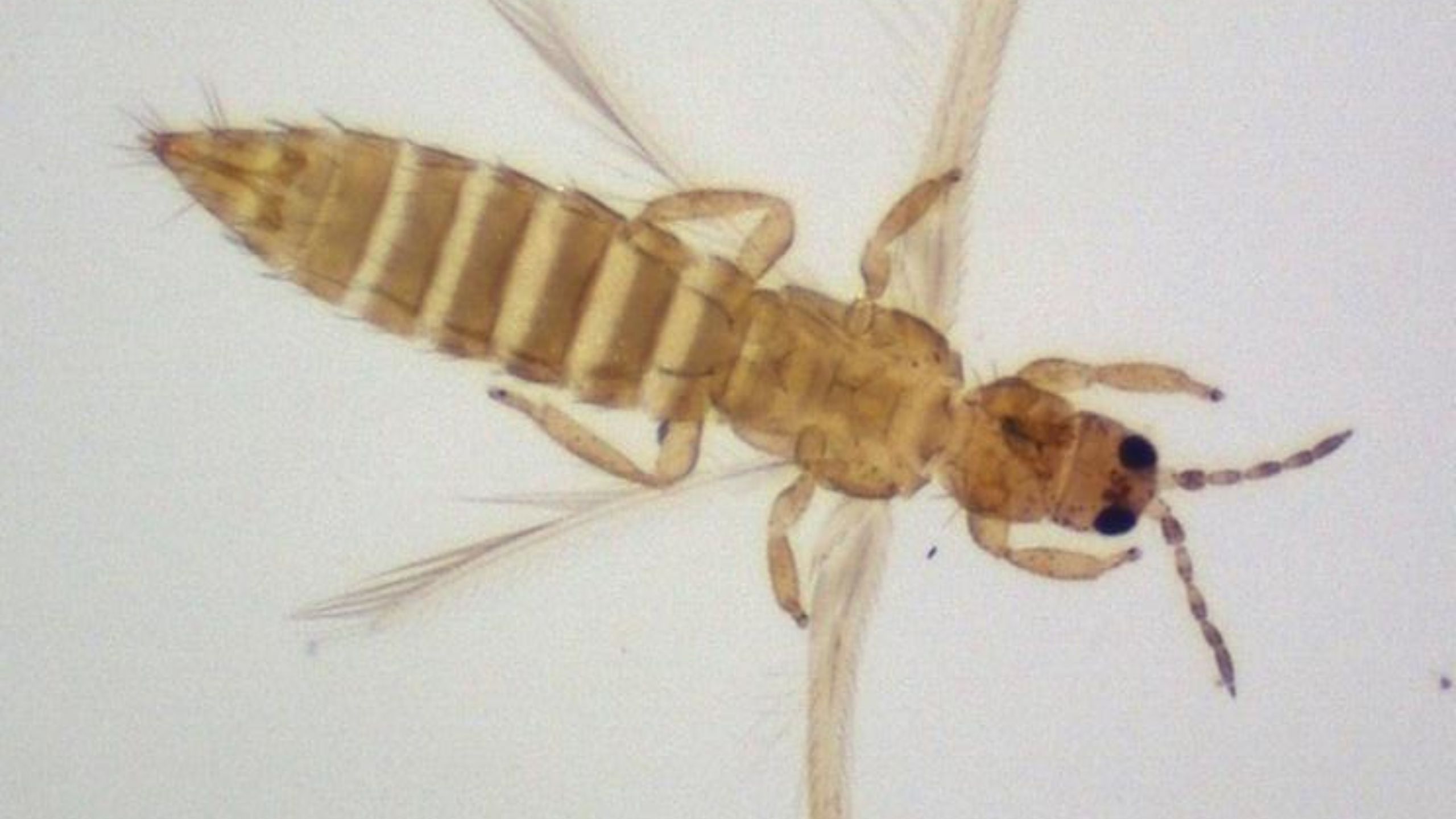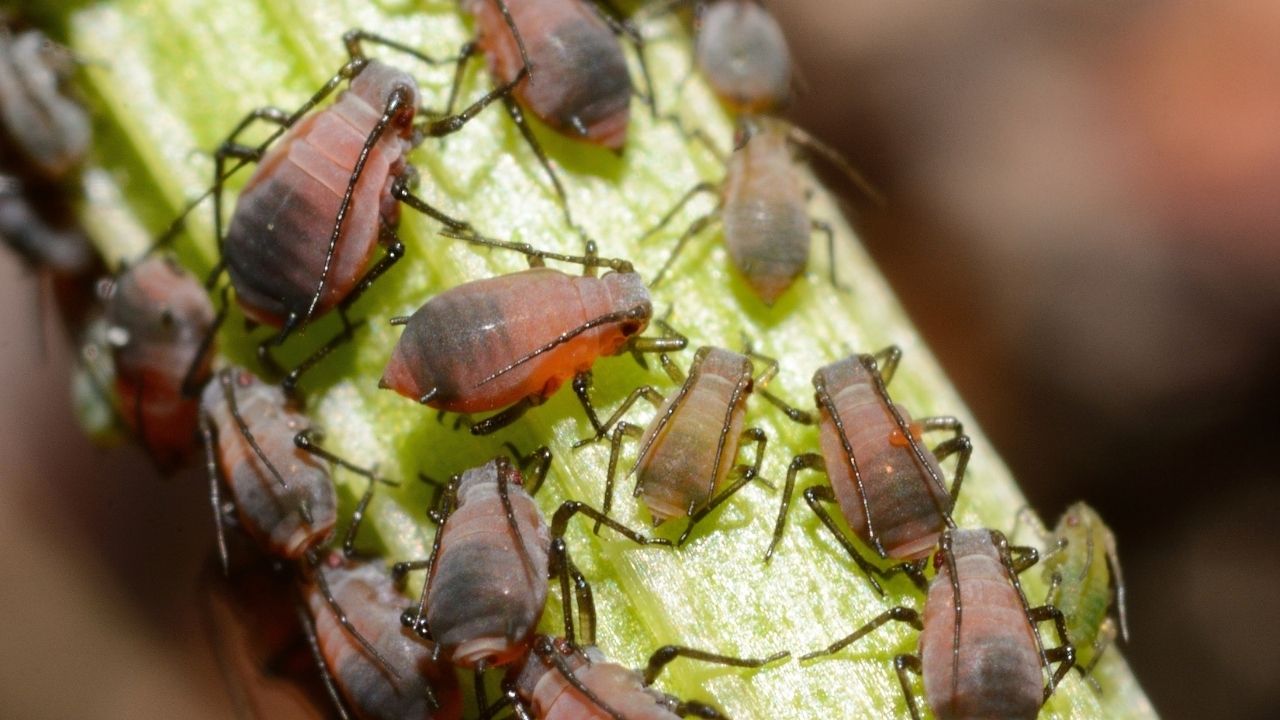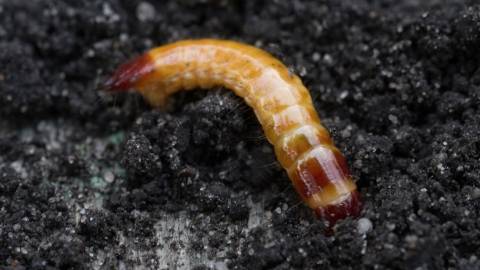Wireworms
June 2020
Ryan Davis, Arthropod Diagnostician (No longer at USU) • Jay B Karren, Extension Entomologist (No longer at USU) • Alan H. Roe, Arthropod Diagnostician (No longer at USU)
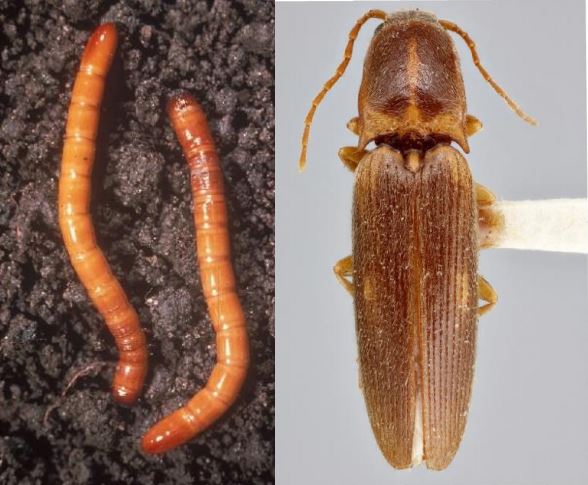
Fig. 1. (Left) Wireworms (larvae of click beetles). Frank Peairs, Colorado State University, Bugwood.org
Fig. 2. (Right) Adult wireworm (click beetle) Paul Langlois, Museum Collections, Coleoptera, USDA APHIS-PPQ, Bugwood.org.
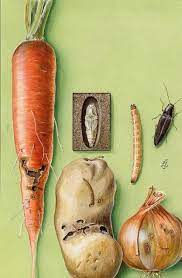
Fig. 3. Wireworm damage and life cycle. Art Cushman, USDA Systematics Entomology Laboratory, Bugwood.org.
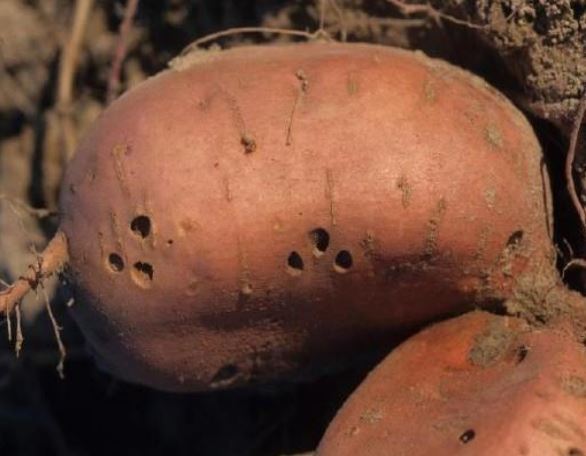
Fig. 4. Wireworm damage in a sweet potato. Gerald Holmes, California Polytechnic State University at San Luis Obispo, Bugwood.org
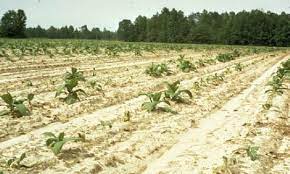
Fig. 5. Wireworm damage in a tobacco field. R.J. Reynolds Tobacco Company Slide Set, R.J. Reynolds Tobacco Company, Bugwood.org.
Quick Facts
- Wireworms are the immature form (larvae) of click beetles.
- Wireworms are 1/4 to 1 1/4 inches long, tan to black and have a smooth, shiny, segmented appearance.
- Severe damage from wireworms in Utah is rare.
- Wireworms live in the soil and feed on seeds, roots, crowns, and stalks of various plants.
- Crops commonly damaged by wireworms include corn, wheat, barley, clover, potatoes, and more.
- Insecticide applications should be made before, or at planting based on bait-based monitoring methods.
Description
Wireworms are click beetle larvae (immatures) (Fig. 1). They range in size from 1/4 to 1 1/4 inches and in color from tan to black. Larvae may be hard, brown, smooth, and wire-like, or soft and white with yellowish-brown heads and tails.
Adult wireworms, or click beetles (Coleoptera: Elateridae) (Fig. 2), are elongate, slender beetles, named from their habit of flipping into the air (sometimes with a clicking sound) when they are placed on their backs. The primary diagnostic feature of click beetles are the two backward-facing spines on the segment behind the head that protrude around the front of the wings (Fig. 2). This can be seen by viewing the adult beetle from above. Members of the genus Limonius (Pacific Coast, sugar beet, western field and Columbia Basin wireworms) are most common in irrigated crops. In areas with less than about 15 inches annual precipitation, the Great Basin wireworm, Selatosomus pruininus, is more common and may be a problem in dryland crops or land that was previously undisturbed rangeland.
Life Cycle
Wireworms require from 2 to 11 years to mature depending on species and environmental conditions. Larvae live and overwinter in the soil and move up or down in the soil profile in response to environmental conditions, primarily temperature. Pupation (changing from a larva into an adult) occurs in cells in the soil from late spring to late summer. The pupal stage lasts for about a month and beetles remain within their earthen pupal cell through the winter. Adults emerge from the soil spring through late summer, mate and lay eggs in the soil, preferably in shade provided by plants. Many larval generations may overlap in the soil; one to many species may also be present in a single field.
Habits and Damage
Wireworms feed on and damage below-ground plant parts, including seeds, roots, crowns, stems, and tubers leading to direct damage, reduction in growth/yield and secondary infection. Larvae of most plant damaging species range from 3/8 to 1 inch when fully grown. Wireworms prefer cereal crops but can readily damage many crops including beans, grains, corn, potatoes and other annual crops (Figures 3 and 4).
Early season wireworm damage occurs when larvae bore into seeds before or during germination. This can prevent germination or kill the seedling before it breaks through the soil surface. Small plants may be killed or stunted when wireworms feed on their root system or bore into the crown. Damaged plants often display wilted leaves. Larvae can cause severe damage to potato by creating tunnels in tubers as they feed. Wireworm damage is often worst in cool, wet spring weather. Infestations do not spread rapidly from one field to another because female beetles are poor flyers. Often, populations of wireworms will have a patchy distribution throughout a field. Wireworms most commonly affect susceptible host crops, especially potatoes, in fields recently converted from weedy alfalfa, clover, grass or pasture. Crop losses in North American crops due to wireworm damage range from 5-25%.
Monitoring
Although wireworms are generally uncommon in Utah, there have been a few cases reported. Once present in a field, wireworms can be difficult to eradicate.
Soil sampling for wireworms is recommended before making management decisions. One simple monitoring method is to visually examine soil following plowing in the fall for the presence of wireworm larvae. Other methods include screening soil cores and combining the use of baits and soil sampling/screening to detect wireworms.
Below is one example of a wireworm baiting/monitoring method outlined by Rondon, et al. (2017). Wireworm thresholds above which treatments are recommended depend on the species, number of larvae in the samples, the sampling method, and the crops concerned (Furlan, 2004). Distribution of wireworms in a field can be patchy so many sample locations may be needed for detection.
Wireworm Monitoring Method
- Fill a nylon, knee-high stocking with 1/2 cup of oats, spring wheat, corn, or barley.
- Soak in water for 24 hours.
- Dig a 6-8 inch deep hole in the soil and place the soaked, knee-high stocking with bait in the soil.
- Distribute traps randomly throughout the field, using about 1 trap per acre.
- Cover each trap hole with dark plastic and let the trap stand for 7-10 days.
- Collect the traps and the surrounding soil with a shovel.
- Sieve soil and trap material to find and count wireworms.
- Begin monitoring at least 3 weeks prior to planting.
- Repeat baiting as necessary and place baits in new random locations rather than reusing old holes.
- In general, an average of 1 or more wireworm per trap is the management threshold.
- An example of management thresholds for wireworms in potatoes from the UC IPM Program can be seen in Table 1
Table 1. Treatment Thresholds of Wireworms in Potato
| Acres in field | Number of soil samples | Treatment threshold (# of wireworms) |
| 10 | 30 | 1 |
| 22 | 45 | 2 |
| 40 | 60 | 2 |
| 90 | 90 | 4 |
| 160 | 120 | 5 |
Management
Cultural Control
- Establish a dense plant stand to reduce the impact of wireworm damage.
- Crop rotation. Fields previously planted in grasses, including grass grains, or pasture are at a higher risk for high wireworm populations. Red and sweet clover and small grains, especially barley and wheat, can increase wireworm populations. Include alfalfa and mustards in crop rotations to reduce wireworm populations over time.
- Sanitation. Remove dead plants and tubers throughout the season and at harvest. Wireworm damage typically peaks at mid season (showing up at harvest as scabbed-over holes in the tubers), and tubers of dead plants can be reinfested, resulting in an increase in wireworm population. Thus, it is important to avoid prolonged periods of time between vine death and harvest.
- Soil drying. Sugar beet and Pacific Coast wireworm (Limonius spp.) populations prefer moist soil and can be reduced by drying the top 15 inches of the soil for several weeks at midsummer. Soil drying targets eggs and young larvae. Soil drying is more effective in light, sandy-to-silt loam soils. Conversely, Great Basin wireworm (Selatosomus pruininus) prefer dry soil and
can be eradicated by converting dryland fields to continual irrigation. - Soil flooding. Thoroughly saturating or flooding soils for at least 2 weeks when soil temperatures are above 68°F will significantly reduce wireworm populations. To increase wireworm mortality, alternate periods of flooding and drying.
- Intensive plowing. Wireworm populations can be reduced by plowing three or more times during late spring and early summer.
- Resistant varieties. There are some resistant varieties that may be worth testing if wireworms are a
potential problem. - Soil health. Maintaining healthy soils with compost, manure, or green manures, may reduce wireworm damage.
- Birds consume some wireworm larvae but do not reduce them below economic levels.
- No effective parasites or biological insecticides are known, and entomopathogenic nematodes are ineffective.
- Proper selection of rotated crops can reduce problems with wireworms
Chemical Control
Insecticide applications should be targeted at wireworms at or before planting based on monitoring. Early season damage to some types of seeds can be minimized using seed treatments. Most insecticides for wireworm control are restricted-use and intended for agricultural use only; they are not meant to be used in home gardens. Insecticides for wireworms are not curative (applied after the plants are growing and show signs of injury), so use previous years’ knowledge and monitoring methods to determine if treatment is necessary prior to current year planting.
Insecticides for wireworm control include liquid and granular formulations, and fumigants. Treatment methods for wireworms include preplant broadcast treatments with soil incorporation, sidedress, in-furrow, and seed treatments. Ideally the treatment should remain toxic until soil temperature is 60℉ at 6-inch depth.Treatments for wireworms should not be applied unless wireworms are known to be present or have caused damage in the previous season.
A few insecticides (active ingredients) that may be used in home gardens for the management of wireworms include bifenthrin (3A), pyrethrins (3A), and zeta-cypermethrin (3A). These active ingredients are commonly available to homeowners in granular or liquid formulations. Homeowners can also bait and mechanically kill wireworms. Dig holes 2 to 4 inches deep and place a bait mixture containing germinating peas, beans, or corn and cover with a board or tile. Place baits at 3 to 10 foot intervals. After one week, uncover the baits and kill the wireworms that have been attracted to the bait.
For commercial producers, granular and liquid formulations labeled for wireworms can be found in Table 2. Primarily, these insecticides are used as preplant granular or liquid applications or fumigants or seed treatments. Using fumigants requires the preparation of a fumigation plan.
Table 2. Some Insecticides Labeled for Agricultural Wireworm Management
| Product Name | Active Ingredient | Mode of Action | Restricted Use |
| Adama Diazinon 50 W | diazinion | 1B | Y |
| Admire Pro | imidacloprid | 4A | N |
| Arctic 3.2 EC | permethrin | 3A | Y |
| Athena | bifenthrin; avermectin B1 | 3A; 6 | Y |
| Aztec | cyfluthrin; tebupirmphos | 3A; 1B | Y |
| Bigrade 2 EC | bifenthrin | 3A | Y |
| Capture LFR | bifenthrin | 3A | Y |
| Counter 20 G Smartbox | terbufos | 1B | Y |
| Cruizer 5 FS | thiamethoxam | 4A | N |
| Diazinon AG 500 | diazinon | 1B | Y |
| Force 3 G | tefluthrin | 3A | Y |
| Gaucho 600 F | imidacloprid | 4A | N |
| Lorsban 50W WSP | chlorpyrifos | 1B | N |
| Mocap | ethoprop | 1B | Y |
| Poncho 600 FS | clothianidin | 4A | N |
| Regent 4 SC | fipronil | 2B | Y |
| Sniper | bifenthrin | 3A | Y |
| Telone II | dichloropropene | 2A | Y |
References and Further Reading
- Arakaki, N., Hokama, Y., & Yamamura, K. (2009). Efficient bait for sampling the wireworm Melanotus okinawensis
(Coleoptera: Elateridae) in a sugarcane field. Applied Entomological Zoology, 44, pp. 561–568. - Barsics, F., Haubruge, E., & Verheggen, F. J. (2013). Wireworms’ management: An overview of the existing methods, with
particular regards to Agriotes spp. (Coleoptera: Elateridae). Insects, 4(1), 117–152. - Brunner, N., Kromp, B., Meindl, P., Pazmandi, C., & Traugott, M. (2004). Evaluation of different sampling techniques for wireworms (Coleoptera, Elateridae) in arable land. In Proceedings of IOBC/WPRS Working Group “Insect Pathogens and
Insect Parasitic Nematodes” Subgroup “Melolontha,” Innsbruck, Austria, 11-13 October; pp. 117–122. - Furlan, L. (2004). An IPM approach targeted against wireworms: what has been done and what has to be done. In:
Proceedings of IOBC/WPRS Working Group “Insect Pathogens and Insect Parasitic Nematodes” Subgroup “Melolontha,”
Innsbruck, Austria, 11-13 October; pp. 91–100. - Genetzky, A., Burkness, E.C., & Hutchison, W.D. (2020). VegEdge: Wireworms. University of Minnesota Extension, IPM Program.
- Kirfman, G.W., Keaster, A.J., & Story, R.N. (1986). An improved wireworm (Coleoptera: Elateridae) sampling technique for
midwest cornfields. Journal of the Kansas Entomological Society, 59, pp. 37–41. - Knodel, J.J., & Govinda, S. (2019). Pulse crops: pest management of wireworms and cutworms in the northern great plains of
United States and Canada. Annals of the Entomological Society of America, 111(4), pp:195–204. - Landl, M.A., Furlan, L., & Glauninger, J. (2011). Seasonal fluctuations in Agriotes spp. (Coleoptera: Elateridae) at two sites in
Austria and the efficiency of bait trap designs for monitoring wireworm populations in the soil. Journal of Plant Diseases and
Protection, 117, pp. 268–272. - Parker, W.E. (1994). Evaluation of the use of food baits for detecting wireworms (Agriotes spp., Coleoptera: Elateridae) in
fields intended for arable crop production. Crop Protection, 13, pp. 271–276. - Parker, W.E. (1996). The development of baiting techniques to detect wireworms (Agriotes spp., Coleoptera: Elateridae) in the
field and the relationship between bait-trap catches and wireworm damage to potato. Crop Protection, 15, pp. 521–527. - Parker, W.E., Cox, T., & James, D. (1994). Evaluation of the use of baited traps to assess the risk of wireworm damage to
potato. In Proceedings of Brighton Crop Protection Conference, Pests and Diseases, 21-24, November, pp. 199–204. - Haviland, D.R., & Trumble, J.T. (2019). UC IPM Pest Management Guidelines: Potato - Wireworms. UC ANR Publication 3463.
- Rashed, A., Etzler, F. Rogers, C.W., & Marshall, J.M. (2015). Wireworms in Idaho cereals: Monitoring and identification.
University of Idaho Extension Bulletin 868, November, 8 pp. - Rondon, S.I., Vinchesi, A., Rashed, A., & Crowder, D. (2017). Wireworms: A pest of monumental proportions. Oregon State
University Extension Service, EM 9166. - Simmons, C.L., Pedigo, L.P. & Rice, M.E. (1998). Evaluation of seven sampling techniques for wireworms (Coleoptera:
Elateridae). Environmental Entomology, 27, pp. 1062–1068. - University of Missouri. (2010). Wireworm baits and preplant decisions for corn. University of Missouri Integrated Pest
Management Program, April.
Related Research


